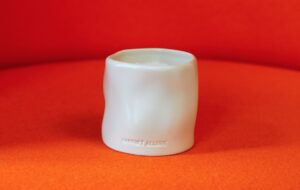|
|
||
|
With his Heath Robinson contraptions and dark imagined futures, Thomas Thwaites has a intriguing take on society, science and technology “Left to his own devices he couldn’t build a toaster,” Douglas Adams wrote in Mostly Harmless (1992). “He could just about make a sandwich and that was it.” Inspired by those words, Thomas Twaites, then a student on the RCA’s Design Interactions course, set out on an odyssey to make a toaster. He bought one in Argos for under £5 and tried to recreate it using raw materials sourced from mines and smelted in chimney pots and microwaves. “The project started with the question, was I man enough to survive in the wild?” he says. “It was an investigation in the economics of scale, trying to locate myself in history, with the generations that have gone before, right back to the iron and copper ages.” The crude result, which Thwaites describes as “a kind of half-baked, handmade pastiche of a consumer appliance”, asked pertinent questions about manufacturing and value. “The whole point of the exercise is that it’s a catalogue of failures,” Thwaites explains. His Chaplinesque endeavour was the subject of a book, a TED talk and a TV programme, and the toaster has just been acquired for the Victoria and Albert Museum’s permanent collection. It is currently on view at the Science Museum alongside that icon of the industrial revolution, Stephenson’s Rocket. Another project, undertaken at University College London’s Centre for Crime and Security Science, looked at the coming age of GM and the real possibility that, using DIY biology, hallucinogens could be disguised as benign plants. To explore such “crime futures”, Thwaites created a fictional Metropolitan Police beekeeping unit, which used insects to collect pollen and, by decoding their waggle dances, monitor genetically modified plants.
credit David Vintiner Sponsored by the Wellcome Trust, Thwaites is currently attempting to simulate what it might feel like to be an animal. Inspired by the philosopher Thomas Nagel’s essay, What Is It Like To Be A Bat?, and using homemade prostheses, he is trying to turn himself into an elephant. The DIY prototype resembles one of Heath Robinson’s useless contraptions. “The plan is to make this a bit better,” he says, suggesting high-tech composite materials. “And the dream is to gallop along the road totally free. At the same time the project’s supposed to ask, could you ever experience what it would be like to be another creature?” Thwaites climbs into a harness suspended from two arches; he puts his feet into a pair of ice skates that operate the back legs and clasps a couple of handles that work the front ones. “I might be making a bit of a fool out of myself,’ he adds. “But sometimes that’s OK.” |
Words Christopher Turner |
|
|
||


















